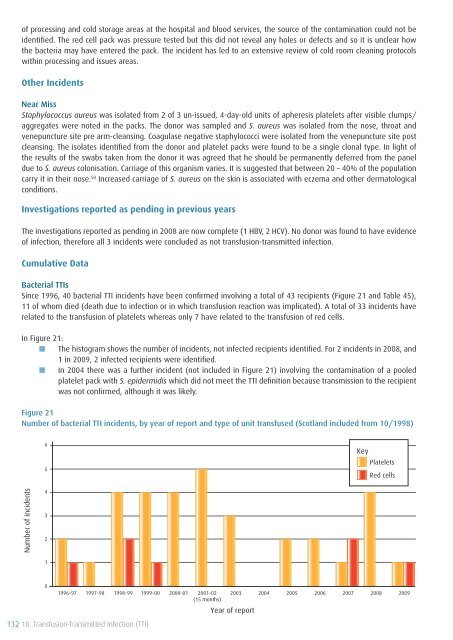SHOT Annual Report 2009 - Serious Hazards of Transfusion
SHOT Annual Report 2009 - Serious Hazards of Transfusion
SHOT Annual Report 2009 - Serious Hazards of Transfusion
Create successful ePaper yourself
Turn your PDF publications into a flip-book with our unique Google optimized e-Paper software.
<strong>of</strong> processing and cold storage areas at the hospital and blood services, the source <strong>of</strong> the contamination could not be<br />
identified. The red cell pack was pressure tested but this did not reveal any holes or defects and so it is unclear how<br />
the bacteria may have entered the pack. The incident has led to an extensive review <strong>of</strong> cold room cleaning protocols<br />
within processing and issues areas.<br />
Other Incidents<br />
Near Miss<br />
Staphylococcus aureus was isolated from 2 <strong>of</strong> 3 un-issued, 4-day-old units <strong>of</strong> apheresis platelets after visible clumps/<br />
aggregates were noted in the packs. The donor was sampled and S. aureus was isolated from the nose, throat and<br />
venepuncture site pre arm-cleansing. Coagulase negative staphylococci were isolated from the venepuncture site post<br />
cleansing. The isolates identified from the donor and platelet packs were found to be a single clonal type. In light <strong>of</strong><br />
the results <strong>of</strong> the swabs taken from the donor it was agreed that he should be permanently deferred from the panel<br />
due to S. aureus colonisation. Carriage <strong>of</strong> this organism varies. It is suggested that between 20 – 40% <strong>of</strong> the population<br />
carry it in their nose. 50 Increased carriage <strong>of</strong> S. aureus on the skin is associated with eczema and other dermatological<br />
conditions.<br />
Investigations reported as pending in previous years<br />
The investigations reported as pending in 2008 are now complete (1 HBV, 2 HCV). No donor was found to have evidence<br />
<strong>of</strong> infection, therefore all 3 incidents were concluded as not transfusion-transmitted infection.<br />
Cumulative Data<br />
Bacterial TTIs<br />
Since 1996, 40 bacterial TTI incidents have been confirmed involving a total <strong>of</strong> 43 recipients (Figure 21 and Table 45),<br />
11 <strong>of</strong> whom died (death due to infection or in which transfusion reaction was implicated). A total <strong>of</strong> 33 incidents have<br />
related to the transfusion <strong>of</strong> platelets whereas only 7 have related to the transfusion <strong>of</strong> red cells.<br />
In Figure 21:<br />
■■ The histogram shows the number <strong>of</strong> incidents, not infected recipients identified. For 2 incidents in 2008, and<br />
1 in <strong>2009</strong>, 2 infected recipients were identified.<br />
■■ In 2004 there was a further incident (not included in Figure 21) involving the contamination <strong>of</strong> a pooled<br />
platelet pack with S. epidermidis which did not meet the TTI definition because transmission to the recipient<br />
was not confirmed, although it was likely.<br />
Figure 21<br />
Number <strong>of</strong> bacterial TTI incidents, by year <strong>of</strong> report and type <strong>of</strong> unit transfused (Scotland included from 10/1998)<br />
6<br />
5<br />
Key<br />
Platelets<br />
Red cells<br />
Number <strong>of</strong> incidents<br />
4<br />
3<br />
2<br />
1<br />
0<br />
1996–97 1997–98 1998–99 1999–00<br />
2000–01<br />
2001–02<br />
(15 months)<br />
2003<br />
Year <strong>of</strong> report<br />
2004<br />
2005<br />
2006<br />
2007 2008 <strong>2009</strong><br />
132 18. <strong>Transfusion</strong>-Transmitted Infection (TTI)












